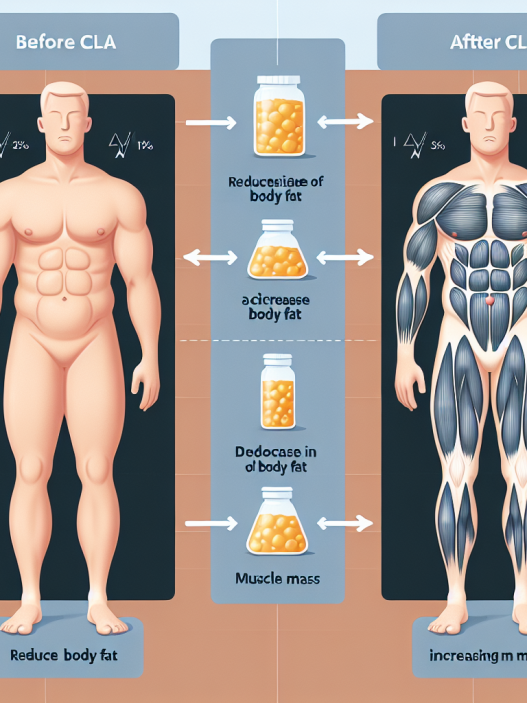-
Table of Contents
Cla and Weight Loss: Winning Formula for Athletes
Athletes are constantly seeking ways to improve their performance and achieve their goals. From intense training regimens to strict diets, they are willing to do whatever it takes to gain a competitive edge. One supplement that has gained popularity among athletes is Conjugated Linoleic Acid (CLA). This naturally occurring fatty acid has been touted as a weight loss aid and has become a staple in many athletes’ supplement routines. But what exactly is CLA and how does it contribute to weight loss? In this article, we will explore the pharmacokinetics and pharmacodynamics of CLA and its potential benefits for athletes.
The Basics of CLA
CLA is a type of fatty acid found in small amounts in meat and dairy products. It is a polyunsaturated fatty acid with a unique chemical structure that sets it apart from other fatty acids. CLA is made up of a chain of 18 carbon atoms with two double bonds, giving it the chemical formula C18:2. These double bonds are what make CLA a conjugated fatty acid, hence its name.
CLA is primarily found in the form of two isomers, cis-9, trans-11 and trans-10, cis-12. These isomers have different effects on the body, with the cis-9, trans-11 isomer being the most abundant and biologically active form. It is important to note that CLA supplements are typically a mixture of both isomers, with varying ratios depending on the source.
Pharmacokinetics of CLA
When consumed, CLA is absorbed in the small intestine and transported to the liver. From there, it is metabolized into various metabolites, including conjugated linoleic acid methyl ester (CLA-ME) and conjugated linoleic acid hydroxy acid (CLA-HA). These metabolites are then released into the bloodstream and distributed throughout the body.
The absorption of CLA is influenced by several factors, including the amount and type of fat consumed with it. Studies have shown that consuming CLA with a high-fat meal can increase its absorption by up to 30%. Additionally, the type of fat consumed can also affect CLA absorption, with saturated fats having a positive impact and polyunsaturated fats having a negative impact.
Once absorbed, CLA has a half-life of approximately 6 hours, meaning it takes about 6 hours for the body to eliminate half of the ingested CLA. This relatively short half-life suggests that CLA should be taken multiple times throughout the day to maintain its levels in the body.
Pharmacodynamics of CLA
The exact mechanism of action of CLA is not fully understood, but it is believed to work through several pathways. One proposed mechanism is that CLA inhibits the enzyme lipoprotein lipase (LPL), which is responsible for breaking down and storing fat in the body. By inhibiting LPL, CLA may reduce fat storage and promote fat burning.
CLA has also been shown to increase the activity of enzymes involved in fat oxidation, leading to an increase in energy expenditure. This increase in energy expenditure may contribute to weight loss and improved body composition.
Furthermore, CLA has been found to have anti-inflammatory and antioxidant properties, which may also contribute to its weight loss effects. Inflammation and oxidative stress have been linked to obesity and metabolic disorders, and by reducing these factors, CLA may help improve overall health and aid in weight loss.
CLA and Weight Loss
The potential weight loss benefits of CLA have been studied extensively, with mixed results. Some studies have shown significant reductions in body fat and improvements in body composition with CLA supplementation, while others have found no significant effects.
One study conducted on overweight and obese individuals found that supplementing with 3.2 grams of CLA per day for 12 weeks resulted in a significant decrease in body fat mass and an increase in lean body mass compared to a placebo group (Gaullier et al. 2004). Another study on healthy, exercising individuals found that supplementing with 3.4 grams of CLA per day for 7 weeks resulted in a significant decrease in body fat percentage compared to a placebo group (Thom et al. 2001).
However, not all studies have shown positive results. A meta-analysis of 18 randomized controlled trials found that CLA supplementation had no significant effect on body weight or body fat in overweight and obese individuals (Whigham et al. 2007). This suggests that the effects of CLA may vary depending on individual factors such as diet and exercise habits.
CLA and Athletic Performance
In addition to its potential weight loss benefits, CLA has also been studied for its effects on athletic performance. One study on trained male athletes found that supplementing with 6 grams of CLA per day for 28 days resulted in a significant increase in lean body mass and a decrease in body fat percentage compared to a placebo group (Kreider et al. 2002).
Another study on resistance-trained individuals found that supplementing with 5.6 grams of CLA per day for 7 weeks resulted in a significant increase in strength and lean body mass compared to a placebo group (Pinkoski et al. 2006). These findings suggest that CLA may have potential benefits for athletes looking to improve their body composition and performance.
Expert Opinion
Overall, the research on CLA and its potential benefits for athletes is promising but inconclusive. While some studies have shown positive results, others have found no significant effects. It is important to note that the effects of CLA may vary depending on individual factors such as diet and exercise habits.
Furthermore, the quality and purity of CLA supplements can also impact their effectiveness. It is important to choose a reputable brand and consult with a healthcare professional before adding CLA to your supplement routine.
References
Gaullier, J. M., Halse, J., Høye, K., Kristiansen, K., Fagertun, H., Vik, H., & Gudmundsen, O. (2004). Conjugated linoleic acid supplementation for 1 y reduces body fat mass in healthy overweight humans. The American journal of clinical nutrition, 79(6), 1118-1125.
Kreider, R. B., Ferreira, M., Wilson, M., Almada, A. L., & Willoughby, D. S. (2002). Effects of conjugated linoleic acid supplementation during resistance training on body composition, bone density, strength, and selected hematological markers. Journal of strength and conditioning research, 16(3), 325-334.
Pinkoski, C., Chilibeck, P. D., Candow, D. G., Esl



















